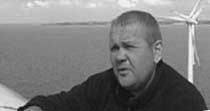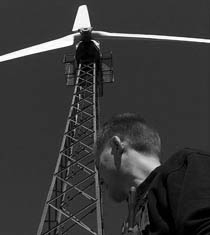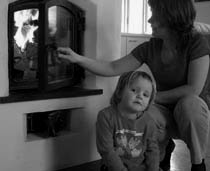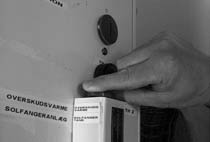Personal Experiences
Erik Koch Andersen
| Name: | Erik Koch Andersen |
| Age: | 61 years old |
| Village: | Besser |
| Renewable energy: | Thermal and PV solar collectors, wood-fired central heating using the farm’s wood. Canola oil mill produces canola oil for the family stationcar and farm tractors. Shares in land and offshore wind turbines. |
Did some particular event spark your interest?
Samsø was acclaimed a renewable energy island and I wanted to contribute. Our first project was an attempt to accumulate methane gas from an old garbage site I had bought.
How has the economics of renewable energy influenced your involvement in these questions?
It’s had no bearing on these decisions whatsoever. I’ve haven’t done the maths and can only say that it has been both interesting and enjoyable to help extract energy from nature without digging for it. It’s been a very gratifying process.
Has your renewable energy system changed your daily routines?
I’m happy when the sun shines, especially when the solar collectors make a surplus of energy.
What do you think about the objective to make Samsø a renewable energy island?
The energy island project is a fantastic initiative and we’ve come much farther than many other projects. Is it possible to reach 100%? There’s a tremendous amount of focus on the island because of the energy island project. I’ve just been on a trip to the USA – 40 degrees and air conditioning everywhere. They could make a lot of energy with all that sunshine.
Do you have good advice to others who might like to invest in similar domestic heating systems?
I’d like to see more joint ventures, at the local level! It’s expensive to do things on your own. For example, my seed mill for pressing rapeseed should be something several could develop together. Other than that, we just have to roll up our sleeves and get at it.
Would you have done things differently if you had to start over?
No, but there have been some problems with my rapeseed fuelled tractors because we don’t have an expert on the island. It would be nice to have a motor expert on the island.
Brian Kjær
| Name: | Brian Kjær |
| Age: | 29 years |
| Village: | Nørreskifte |
| Renewable energy: | A domestic windmill (Vestas 22kW), 6m2 solar thermal panels, wood pellet furnace. |
What triggered your interest in renewable energy?
Samsø’s status as a renewable energy island. I’m an electrician and renewable energy enthusiasts asked a lot of questions about flow management and optimisation of solar and wood pellet setups. That got me interested and I started with my own installations.
Did some particular event spark your interest?
Several of us participated in a wind turbine course for electricians at the Vestas wind turbine plant in Brande because our electrician firm was hired to service Samsø’s windmills. They had several smaller used turbines taken down to make room for larger wind turbines. These used windmills would make excellent domestic windmills if they could be scaled down to the allowed maximum capacity, 25 kW. I asked the island energy consultant Søren Hermansen how to go about getting permission to erect a domestic windmill in our yard.
How has the economics of renewable energy influenced your involvement in these questions?
Our investment in the wood pellet furnace was an economic decision. The savings compared with the cost of heating with fuel oil were substantial. The solar thermal panels were more a matter of interest. The transition to wood pellets went well, but it was not being used efficiently during the summer when the only heat needed was hot water. Solar panels fill the gap and extend the life of the furnace. The windmill is my primary interest. It took me a whole year to find a used windmill I could set up – the used ones taken down to make room for larger windmills cannot be set up again in Denmark but have been exported to other countries.
What have you earned or saved in dollars and cents?
I don’t really know yet, because one investment has lead to another. The wood pellet furnace and solar panels are saving us about 10.000 Danish crowns () a year in heating costs. The windmill has reduced our electricity bill by 3 – 4000 crowns a year (about $600-600 US).
Has your renewable energy system changed your daily routines?
My wife peeks out the window to see if the windmill is turning before washing clothes. It’s not something we have talked about, but if there’s no wind she postpones the washing a little. We just appreciate windy days a little more!
What do you think about the objective to make Samsø a renewable energy island?
I’m very happy with the energy island project. Islanders heard that I worked with heat pumps, wood pellet furnaces and windmills and many of them have looked me up to get advice.
Do you have good advice to others who might like to invest in similar domestic renewable energy systems?
It pays to be well informed before you invest. Projects like setting up a used windmill have to be followed up with the time and money it takes to get them running properly.
Would you have done things differently if you had to start over?
I replaced my windmill with a larger windmill and can’t recommend this move. It’s too big to handle alone and requires professional assistance to install and repair. But once the decision was made and the components bought, I had to keep at it and finish the project.
Top
Cecilia Andersen
| Name: | Cecilia Andersen |
| Age: | 43 years old |
| Village: | Agerup |
| Renewable Energy: | Wood pellet burner heats 400 m2, Finnish mass fireplace and a traditional wood burner. These replaced the oil furnace and old radiators. |
What triggered your interest in renewable energy?
Moving into an older home meant making some decisions – the house wasn’t really functional. And money made a difference. It was far too expensive to heat our old house with fuel oil. We did consider a ground to water heating system, but the wood pellet boiler is a better choice in a large house with lots of space.
Did some particular event spark your interest?
I grew up with renewable energy. We had wood burners and a windmill in my childhood home. It’s been a natural choice for me to choose renewable energy, while my husband relied more on an assessment of the economic consequences.
How has the economics of renewable energy influenced your involvement in these questions?
The financial aspect has been crucial for the choice of the wood pellet furnace, because we wanted to cut the heating costs of living in such a large house. The Finnish mass fireplace is also en economically sound choice because we have quite a lot of firewood on the property, but it also adds a beautiful sculptural aspect to the kitchen, something both cozy and authentic. We thought we would use the mass fireplace for cooking as well, but have to admit this hasn’t happened very often.
What have you earned or saved in dollars and cents?
We can’t compare with a whole year’s heating expenses before we made the changes, but we use about 12 tons of wood pellets a year. The equivalent amount of energy in oil would be much more expensive. We don’t use the wood pellet boiler in the summer months.
Has your renewable energy system changed your daily routines?
Our renewable energy systems are a big change compared with life in an apartment where you just turn the heat up or down. We fill up the wood pellet bin every 2-3 days, and empty ashes and vacuum the burner every two weeks. Cutting, splitting and stacking wood for the mass fireplace and wood burner also entails a lot of work.
What do you think about the objective to make Samsø a renewable energy island?
It’s a fantastic project and idea and I’m very happy to live on an island with such wonderful objectives. Many more areas should be doing the same thing and I’m sure that the commercial arguments for this development will soon prevail. Renewable energy was at one time a question of ideology, but it’s more and more a necessity – and lots of homes are investing in wood pellets furnaces on economic grounds alone.
Do you have good advice to others who might like to invest in similar domestic heating systems?
Running a wood pellet furnace involved a certain amount of work, but everyone I know with wood pellet furnaces are quite happy with their choice. Visiting other homes with renewable energy installations is a really good idea, especially homes that resemble your own. Ask them about their own experiences and assessment of the pros and cons. You’ll have a much better idea about what is involved. For example, we didn’t realize that there has to be room for firewood indoors, near the fireplace, certainly much more than the few pieces of wood shown in the advertisements.
Would you have done things differently if you had to start over?
No, I would like to expand with our own windmill, but that’s another matter.
Top
Bo Agerskov
| Name: | Bo Agerskov |
| Age: | 52 years old |
| Village: | Besser |
| Renewable energy: | 18 m2 solar thermal heating. 50 kw Passat woodboiler with 2800 liter thermal storage tank. This system replaced an older woodboiler. |
What triggered your interest in renewable energy?
I guess it was that special mix of economics and environmental good sense, not to mention the rocketing fuel oil prices. My system is set up to allow further expansion, for example hooking up to a Danish heat producing windmill, the Calorius. With one of these we would be 100% self-sufficient with renewable energy, a goal we’d like to meet.
Did some particular event spark your interest?
I think it has always interested me. But anyone with an interest for current affairs and the daily news can draw conclusions about renewable energy which should make them reconsider their energy consumption.
How has the economics of renewable energy influenced your involvement in these questions?
The financial aspect hasn’t been the most important. It’s the challenge, whether or not it can be done which motivates me primarily, although I do believe the investment to be sound enough in the long run.
What have you earned or saved in dollars and cents?
The new heating system cost about $30,000. We haven’t had it a full heating season yet, so it’s hard to say how much we’re saving in hard cash, but our wood consumption has fallen from 40 m3 to 25 m3.
Has your renewable energy system changed your daily routines?
Not really. Heating the house with wood is now easier, because I only need to light the fire once a day or in milder weather every second day.
What do you think about the objective to make Samsø a renewable energy island?
The energy island project is a really good idea and seems to be well-known both locally and internationally.
 The water fra the solarpanels is stored in a tank with 3000 liters of water.
The water fra the solarpanels is stored in a tank with 3000 liters of water.Do you have good advice to others who might like to invest in similar domestic heating systems?
I can recommend a system like mine – everything works like a clock. Ole Hemmingsen (one of the local blacksmiths who have made renewable energy systems an important part of their company profiles) did the plumbing and installation and everything is tiptop. We weren’t sure that so many square meters of solar panels was an economically viable choice, but I’m convinced now. On a sunny day in the beginning of February the hot water from the solar panels heats up to 65-70 ºC. Pretty impressive when the outside temperature is hovering at freezing point.
Would you have done things differently if you had to start over?
Some small sections of the piping have been changed and with foresight would be planned properly. As a whole, the project has been underway quite a long time and I was quite sure what I wanted. I checked out the specifications of a ground-to-water heating system, but the electric consumption was excessive, and how much renewable energy does the system generate when it uses so much electricity?
Top
Jørgen Tranberg
| Name: | Jørgen Tranberg |
| Age: | 53 years old |
| Village: | Nørreskifte |
| Renewable energy: | Owns a Bonus 1 MW wind turbine on his property and half an offshore wind turbine rated at 2.3 MW, all told an investment of 19 million Danish crowns (aprox. $3.2 million US) |
What triggered your interest in renewable energy?
You don’t invest 19 million crowns just for the fun of it. It was easier when you just bought a few windmill shares because it was good for the environment and other widely accepted values. Large scale investments have to be economically viable.
Did some particular event spark your interest?
I remember standing at the smithy on the top of the hill in Brundby, shortly after moving to Samsø – and thinking, it’s almost as windy here as it in Western Jutland where I grew up. The windmill projects started shortly thereafter.
How has the economics of renewable energy influenced your involvement in these questions?
I have all along expected a reasonable return. We’ve just had a gear breakdown that cost a million crowns to replace, so there are ups and downs that cannot be foreseen, but it should still work out OK.
What have you earned or saved in dollars and cents?
The overall return still depends very much on the prices we get for our electricity from year ten to twenty. The best thing to do is to accumulate production profits to offset unforeseeable expenses, rather than using the money in the household budget.
Has your renewable energy system changed your daily routines?
You certainly notice the wind. Windy weather isn’t good weather for spraying the fields, but rain makes the grass grow, wind is good for windpower production and the sun makes a boat trip pleasant. All kinds of weather are welcome, except sleet and hail! After the first ten years I’ll be watching the electricity prices more closely, when they start fluctuating more. When you sell 6.5 million kWh a year, a price difference of 10 Danish øre (two cents US) means 650.000 Danish crowns ($130,000 US).
 Jørgen Tranberg in the top of hes ofshore investment
Jørgen Tranberg in the top of hes ofshore investmentWhat do you think about the objective to make Samsø a renewable energy island?
The energy island project has been very interesting. I’m an active participant and my days would be very different without this project. I spend a lot of time working on energy island related issues, at least an hour a day.
Do you have good advice to others who might like to invest in similar domestic heating systems?
Go for whatever you find gratifying – if you believe it is feasible. But don’t stake your entire pension plan in one field like renewable energy. Markets and subsidies can change overnight. When we started no one was interested in CO2, now we’re updated on climactic change ten times a day. Everyone seems to have acknowledged that the temperature is rising, except those buying seaside building lots.
Would you have done things differently if you had to start over?
Not especially, nothing major anyways. At the moment I’m frustrated that we don’t have the capacity to press canola oil to fuel our tractors and cars. That has to be our next project!
Top
Christian Hovmand
| Name: | Christian Hovmand |
| Age: | 78 år |
| Village: | Mårup |
| Renewable energy: | 16 PV solar panels in collaboration with the national 1000 solar cell systems, 20 shares in the onshore Tanderup wind turbines and 25 shares in the offshore wind turbine project south of Samsø (Palludan Flak). |
What triggered your interest in renewable energy?
When I was a school principle, I received a lot of advertisements from different companies. One sent a little pocket calculator I still use 17 years later. It used a little solar PV cell and the opportunity to install PV solar cells on my own roof in collaboration with the 1000 project really woke me up and got me interested.
Did some particular event spark your interest?
The PV solar1000 project made the difference, but less dependence on Middle East oil and less CO2 reductions were also good arguments worth listening to.
How has the economics of renewable energy influenced your involvement in these questions?
None whatsoever! I’m of course quite happy when I can see some savings, which means the money can be used for something else. But for me it’s more important to reduce our dependency on oil from the Middle East. We have our own gas and oil at the moment, but what will we do when this is gone?
What have you earned or saved in dollars and cents?
I have no idea what I have earned or saved. My objective has been to reduce our electricity costs as much as possible, and the power generated by the solar cells makes the meter run backwards if it exceeds our own consumption. Last year our registered electricity consumption was only 441kwh and the utility company said that couldn’t possibly be correct (Average consumption in a energy conscious family home is about 1000 kwh a person, ed.).
em>Has your renewable energy system changed your daily routines?
I started reducing our electricity consumption before we invested in the PV cells. We use low-energy bulbs and turn off the TV and computer so they don’t use standby current. I turn off the computer when I’m not using it – I’ve time enough and can wait the extra minute it takes to start it. Lots of people I know leave them on all day even though they’re not in use. There hasn’t been as much sun this year, but our new Energy class A kitchen stove will hopefully compensate for the fall in our PV electricity production.
What do you think about the objective to make Samsø a renewable energy island?
This project has had my full support from the very start. I had also hoped that Samsø played a more central role in the PV cell 1000 project, which didn’t happen. The next important step is to get started with hydrogen and fuels cells – I’d hate to see Iceland get ahead of us on that one.
Do you have good advice to others who might like to invest in similar domestic heating systems?
Cooperation with a national energy programme like PV 1000 was much easier than I had imagined. All I had to do was remove a few shrubs. They came and installed everything in no time. Nothing could have been easier.
Would you have done things differently if you had to start over?
Not really. At the moment I’m contemplating the possibility of converting my car to run on rapeseed oil (canola).
← Back to “Knowledge” – Top


![[Archive]Energiakademiet.dk](https://arkiv.energiakademiet.dk/wp-content/themes/deadline-responsive-child-theme/img/logoEN.jpg)














